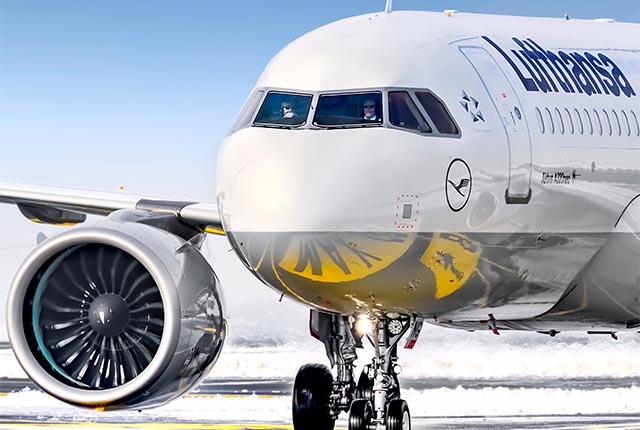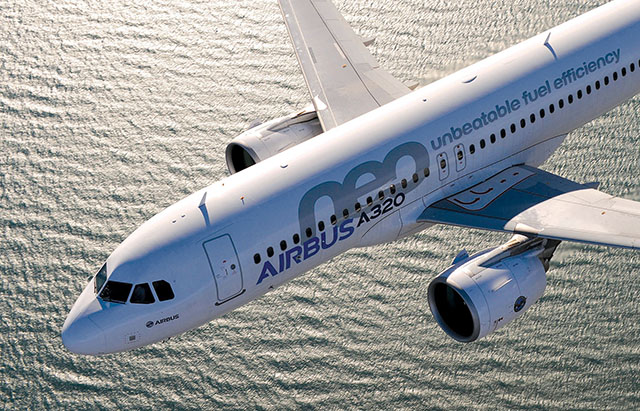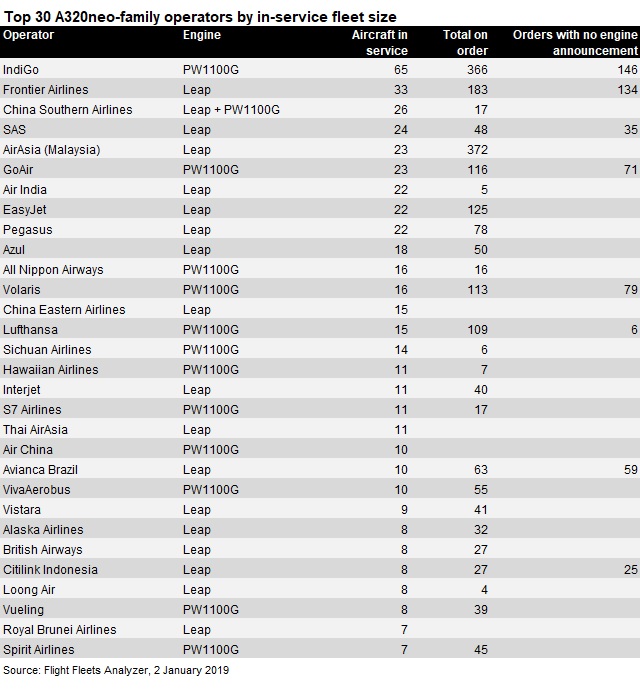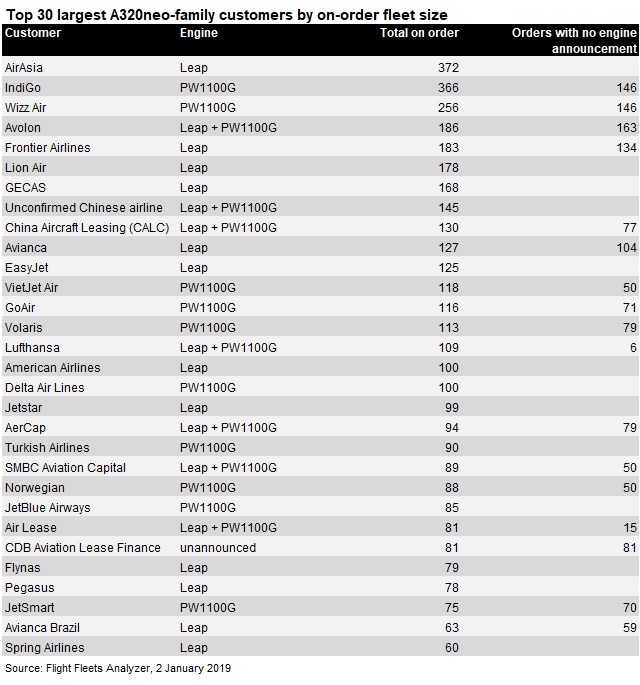Nearly three years on from first delivery, the Airbus A320neo family is, in sales terms, an undoubted success story. More than 60 operators have the aircraft in service.
However, a significant number of these have had to contend with either engine-related performance issues or late aircraft deliveries. Perhaps partly as a consequence of this, several operators declined to be interviewed by FlightGlobal about their in-service experience with the re-engined narrowbody.
Still, where fuel burn is concerned, the aircraft appear to excel. When Lufthansa's Klaus Froese – chief executive of the airline's Frankfurt hub and active line captain – scans A320neo cockpit instruments at cruising altitude, his eyes often stop at the "really fantastic" fuel-flow indications, he says, describing the figures as "noticeably different" from what he is used to seeing on the airline's older A320s.

AirTeamImages
An engine's fuel flow is usually measured in thousands of kilograms per hour, but the figure for the re-engined narrowbodies frequently drops to three digits. "You notice [the fuel savings] when you fly the aeroplane – not just in terms of book-keeping at the office desk," says Froese.
Having selected Pratt & Whitney's PW1100G geared turbofan for an initial A320neo fleet, Lufthansa became the aircraft's launch operator in 2016, after Qatar Airways declined the role. The Middle Eastern carrier's decision was linked to technical issues with the GTF powerplant.
Lufthansa opted to equip about half of its on-order A320neo fleet with the alternative CFM International Leap-1A engine. Deliveries of these aircraft are scheduled to begin in 2021.
MORE POWER, LESS FUEL
From a pilot's perspective, the new engines have provided a quieter, more comfortable flightdeck. In addition, there have been minor updates to the cockpit information and menu navigation within the flight management system. By Froese's account, the new twinjet is "fun" to fly for pilots, as it has more thrust and a better climb performance than the A320ceo.
This view is echoed by AirAsia, which, having introduced its first Leap-powered A320neo in 2016, says the aircraft "feels more powerful [to pilots], and has a distinctive engine sound". The airline notes that A320neo operations are "very similar to the A320ceo, with only minor variations to standard operating procedures".
Lufthansa says its A320neos are fulfilling P&W's promise of 16% fuel savings versus previous-generation aircraft.
The airline has calculated that on a per-seat basis its 180-seat Neos deliver a fuel saving of 21% versus its oldest A320s, which can accommodate 168 passengers. Flight Fleets Analyzer shows that the oldest aircraft in Lufthansa's roughly 180-strong A320-family fleet are 29 years old and powered by CFM56-5As.
Avianca tells FlightGlobal that its Leap-powered A320neos offer 15-20% lower fuel consumption in cruise than first-generation Ceos – a saving the Colombian carrier's engineering director Adolfo Carvajal describes as "huge" on flights longer than 4h.
However, the introduction of Airbus's updated "bread and butter" aircraft has been marred by multiple engine issues – largely centred on, but not limited to, the GTF – and delivery delays resulting from production and supply-chain hold-ups.
All new aircraft are affected – to varying degrees – by teething issues. What has made the A320neo situation more painful – for operators, Airbus, and suppliers – is the high production rate at which the switchover from the A320ceo is taking place.
When the previous generation of engines was introduced during the 1990s, for the A320 and Boeing 737, problems that might have surfaced during the initial production run and in-service period affected a much smaller number of aircraft and operators.
Not only was the exposure to potential problems much smaller, but it was likely easier for manufacturers to incorporate changes in the production process without creating substantial bottlenecks and consequent delivery delays.
START-UP ISSUES
Lufthansa and other airlines' initial operations with the GTF were severely affected by a rotor-bow problem that led to increased start-up times.
While A320ceos require about 2min to start up both engines, the procedure initially took 6-7min on the Neo as the GTFs were spun up for several minutes – without injecting fuel – to reduce any rotor temperature differential between the cold and hot sections.
The extended start-up time created a headache for Lufthansa, especially at its Frankfurt base. As Germany's largest hub has cul-de-sac bays with multiple aircraft stands, departing Neos were holding up other flights and disrupting the airport's traffic flow.
P&W responded with a number of modifications in 2016, including software changes, strengthened shaft bearings, and the introduction of a dual-cooling push-button in the cockpit, enabling pilots to save some time by beginning to spool up the second engine while the first was still in the start-up process.
Froese acknowledges, however, that Lufthansa struggled with the start-up issue for "a long time", and that it was not resolved until late 2017. "It is really inconvenient for an airline battling for productivity improvements to be wasting time on something like that," he says.
Start-up times have been reduced to what he calls a "just about acceptable" level of 2-3min, depending on weather conditions. But Froese notes that the Neo still takes longer to start than the A320ceo.
P&W says that while the GTF's start-up times were initially "longer than expected", they are now, following the modifications, "within industry standards". The manufacturer notes: "Because the [GTF] operates at higher temperatures than earlier-generation engines, it can take longer to dissipate the heat gradient within the engine prior to start."

Avianca, meanwhile, gives a glowing review of its A320neo-family jets.
"Our entry into service was fantastic," says Carvajal, citing the aircraft's fuel efficiency, the quietness of its Leap engines and a positive reception from passengers. "All [these] variables gave it an excellent entry into service with our company."
Having received its first Neo in 2017, the carrier and its corporate affiliates under Avianca Holdings have nine A320-family jets (seven A320neos and two A321neos) in service, with about 120 more aircraft to follow through 2025. Carvajal acknowledges that a number of early Neo deliveries were delayed by Leap production bottlenecks, but describes the hold-ups as largely insignificant.
AirAsia, meanwhile, says a few of its A320neo deliveries were delayed – mainly for the same reason – but the majority arrived on schedule. Flight Fleets Analyzer shows that AirAsia's Malaysian operation has 23 A320neos in service, with another 372 A320neo-family jets on order. Part-owned group affiliate Thai AirAsia has 11 Neos in service. The delivered aircraft have performed well in service, AirAsia says.
In addition to lower fuel burn, oil consumption has been halved compared with the CFM56-5B, and routine maintenance requirements have been reduced too, the airline says.
The only major in-service issue experienced on the Leap so far has been the premature degradation of a thermal barrier coating on high-pressure turbine shrouds. To resolve the issue, CFM changed the application process for the coating in 2018.
AirAsia has also experienced reliability issues with starter air valves, fuel nozzles and pressure sensors, anti-ice valves, and variable-bleed valve actuators. But the problems have been or are in the process of being addressed, the airline says. It adds that its Neos' technical dispatch reliability is "comparable" to that of its Ceos.
VIBRATIONS
Lufthansa's in-service experience with the Neo has entailed a series of technical issues – mainly with the engines – separated by periods of relative stability. The latest issue centres on vibrations of the high-pressure rotor (N2) shaft, which have been observed on several PW1100G engines. Froese says the vibrations are not noticeable by occupants on board, but have been picked up by engine instrumentation.
P&W says that less than 2% of in-service powerplants have been impacted by "transitory engine vibration". The manufacturer has not disclosed the vibration source and told FlightGlobal in December that engine tests were still being conducted to understand the issue. No in-flight engine shutdown incidents have been associated with the vibrations, P&W stresses.
Lufthansa says the vibrations – which were registered over time as engines matured – are typically encountered during early flight phases after take-off.
As P&W mandates operators to replace engines once a certain vibration strength or event frequency has been reached, Lufthansa has had to take several powerplants off wing. "This is something that has kept us busy indeed over the past months, because we repeatedly reached a [vibration] range where we had to replace engines," Froese says.

Anthony Pecchi/Airbus
He notes that the operational challenges with the GTF would be much easier to cope with if the supply of spare engines were more plentiful. Lufthansa has frequently operated for long periods with no spare GTF available at its base, Froese says. While it has spare engines in storage for other aircraft in its fleet, the carrier tends to receive spare GTFs from P&W only in an aircraft-on-ground scenario.
P&W is caught between two opposing requirements for engine output: on the one hand it has to meet Airbus's ramp-up plan (and recover from earlier delays), and on the other it needs to supply spare engines to increasingly frustrated end-users.
Airbus says that after GTF deliveries were suspended for eight weeks until April 2018 because of a flawed seal in the high-pressure compressor, the airframer decided with P&W to prioritise engine deliveries to airlines – for the support of in-service aircraft – rather than to the assembly lines for new aircraft.

For airlines, performing daily fleet operations without spare engines at hand poses particular challenges.
Froese describes spare engine supply as a "very dynamic business", to which Lufthansa has dedicated staff to "protect our interests". And while engine replacements in regard to the vibration issue are – to a certain extent – predictable, he says the spare-engine situation has remained "very difficult", despite "intensive talks" with P&W.
The manufacturer says that it is in the process of ramping up spare-engine supply to operators and to P&W's pool and of increasing MRO activity in order to "meet our customers' expectations for on-site spares. Spare engines are allocated to the best of our ability to minimise operational disruption." P&W adds: "This effort will continue into 2019."
The engine maker describes 2018 as "the year of catch-up", as both GTF production and MRO output were nearly doubled compared with the previous year. "We are maturing the production and MRO facilities faster than any other programme in our history and, clearly, demand continues to rise," says P&W.
'ABSOLUTELY UNSATISFACTORY'
Lufthansa declines to specify a technical dispatch reliability figure for its A320neo operation – citing a limited fleet size – but says it is clearly below the airline's fleet-wide goal of 99.8%. Froese asserts that the Neo's technical reliability has not substantially improved since service entry.
Flight Fleets Analyzer shows that the Star Alliance carrier has 15 A320neos in service, and another 109 A320neo-family aircraft on order, including 40 A321neos. At the end of September, aircraft in Lufthansa's then-13-strong Neo fleet were operating for around 20% less time per day than the carrier’s A320ceos, the airline says. On average, per day, the Neos were operating for 73% as long as same-age Ceos and 92% as long as Lufthansa's oldest Ceos.
At the same time, the Neos' unscheduled ground times were five-and-a-half times as long as those of same-age Ceos, while maintenance costs were around 60% higher, the airline says.
Noting that the re-engined aircraft are meant to become the central pillar of Lufthansa's European operation, Froese describes the airline's in-service experience with the A320neo so far as "absolutely unsatisfactory", despite "intensive maintenance". He acknowledges that both Airbus and P&W have been available to discuss the operator's concerns, but says: "In terms of [operational] results for the engines, we would have wished for something else."
P&W puts the engine dispatch reliability of the in-service GTF-powered Neo fleet at 99.91%, which, it adds, "compares favourably to other early-phase engine programmes".
Responding to Lufthansa's observations of comparatively low Neo utilisation and high maintenance effort, P&W says: "There are no operational restrictions on the PW1100G-JM that would result in such a reduced level of performance." Instead, the manufacturer suggests that low utilisation might be a result of individual circumstances as "operators make their own decisions on aircraft route structure and utilisation".
P&W insists that the GTF is "capable" of meeting the operational levels of the previous-generation International Aero Engines V2500 – the US manufacturer is the largest shareholder of that programme – and that "we are seeing increasing levels of utilisation" for the GTF.
Airbus acknowledges that P&W still has to deliver upgrades and that efforts to modify in-service engines will continue into 2019, but says the GTF's technical issues have "largely been addressed". The entire in-service Neo fleet's operational dispatch reliability is "very close to target" at 99.6%, says Airbus – adding that there now is "less disparity" between Ceos and Neos.
On maintenance costs, P&W argues that while V2500 operators have "benefited from 30 years of continuous improvement", the GTF is still "early in its life cycle".
Costs for maintenance efforts on the GTF will almost certainly be borne by P&W, as engines are still under warranty and a majority of the in-service fleet is covered by hour-based service agreements with the manufacturer. But of course, airlines face additional disruption-related expenses when aircraft are not serviceable – or are not available in the first place because of delivery delays, which have affected multiple operators of both Leap- and GTF-powered Neos.
DELIVERY DELAYS
The hiatus in GTF deliveries last year and a separate, parallel Leap production delay – a product of supply-chain bottlenecks – led to an accumulation of engine-less Neos at Airbus's assembly lines. This peaked at more than 100 aircraft in June.
While that number has since been reduced, Airbus said in December that the backlog would "not be fully cleared by year-end". The airframer foresaw that fewer than 10 aircraft would be taken across to 2019.
Having revised its output targets after the delivery pause in 2018, P&W is now handing over engines in line with the new plan, Airbus says. Meanwhile, the airframer says CFM had "not fully" caught up in December with its plan of overcoming the production delay by the end of 2018.
Airbus acknowledges that more effort is required to stabilise and ramp up Neo production, but says it is on track to reach a target rate of 60 deliveries per month by mid-2019.

Among affected operators is Hawaiian Airlines, which had to postpone new route plans and return a retired 767 to service as a consequence of months-long A321neo hold-ups.
"The biggest challenge we faced is the delivery delays," Hawaiian chief executive Peter Ingram tells FlightGlobal, expressing particular frustration with the GTF delivery freeze. "That was a major disruption to our plans for [2018], and we had to make some significant schedule changes." Delays aside, however, Ingram has repeatedly praised the A321neo's operational capabilities and efficiencies.
Lufthansa had by September received 13 out of some 20 A320neos that had been scheduled to be in operation with the carrier at that point. As new aircraft did not arrive, old equipment could not exit the fleet as planned.
But as previous maintenance efforts had been focused on keeping the old aircraft in service only until their planned departure, the airline had to catch up on maintenance which, Froese says, "often pumps fresh life into the aircraft which you are not going to use".
He says Lufthansa has so far been able to avoid having to wet-lease external capacity to operate its schedule, despite late arrivals of new aircraft. But he asserts that the carrier is "scraping by, from month to month" with the available fleet, and that the situation is "to our economic disadvantage".
In order to cushion the effect of the Neo delivery delays, Lufthansa ordered nine additional A320ceos – scheduled to arrive between December 2018 and summer 2019 – that were not part of the airline's original fleet plan.
If the price of fuel rises again as seen during much of 2018 – before they eased in the autumn – the Neo's fuel-economy benefits will become more pronounced than over the type's first three years of operation.
Froese says, however, that the A320neo's overall economic advantages must be assessed against the aircraft's acquisition cost – Airbus lists a $9.6 million difference between the two generations of A320 – and operational performance over a long period.
He suggests that any fuel savings could be wiped out by additional costs generated by maintenance or reliability issues. "The engines are highly expensive [and require] a lot of maintenance, I would say, but [have] much lower fuel consumption. I am curious how the [overall] bill looks like in 10 years' time.”
With a nod to the fuel price, he quips: "God forbid it falls."
In Froese's view, Lufthansa's main lessons from the A320neo introduction have been to allocate more reserve capacity in general and to expect more disruption during major operational changes.
He thinks that while airlines have increased utilisation of their assets, the risks associated with introduction of new technology or processes are not sufficiently recognised in operators' economic analyses for such projects.
Noting capacity limitations across the air transport sector – at carriers, manufacturers, airports and air traffic control providers – Froese says: "We notice it everywhere… Buffers within aviation's production system have become so thin that minimal disturbances are enough to substantially disrupt the system.
"If we want to have more stable operations, we need more buffers and reserves," he adds.
Unsurprisingly, Airbus offers a short-and-sweet summary of the main learning – and one which is clearly directed at the engine manufacturers. The airframer says it is necessary to have "more extensive engine tests in the engine OEM test cell and also on [Airbus's] flying testbed".
Source: FlightGlobal.com


























